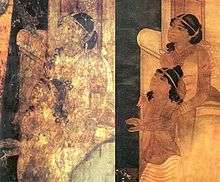Christiana Herringham
Christiana Jane Herringham (Lady Herringham) (1852–1929) was a British artist, copyist, and art patron. She is noted for her part in establishing the National Art Collections Fund in 1903 to help preserve Britain's artistic heritage.

Life
Herringham was born in Kent and was the daughter of Thomas Wilde Powell, a wealthy patron of the Arts and Crafts Movement.[1] In 1880 she married the physician Wilmot Herringham, (later Sir Wilmot Herringham) with whom she had two sons. She was committed to women's suffrage from 1889 onwards.
She was involved on founding the Society of Painters in Tempera in 1901. It had little impact on academic painters, but influenced Joseph Southall.[1] In 1906 she founded the Women's Tribune tabloid before she went to India.[2] The magazine was recreated as Women and Progress by Nora Vynne and it was published until 1914.[3]
In 1910, having travelled to India with her husband, Herringham became involved in the promotion of Indian Art in the UK through her friendship with William Rothenstein. Ernest Havell and Rothenstein formed the India Society and Herringham joined the committee. She was the only female committee member at the time. The Society would often meet at her home at 40 Wimpole Street in London, which was later destroyed during The Blitz. Her husband became Chair of the India Society committee in 1914.
Herringham, however, had begun to suffer from delusions of pursuit and persecution. In 1914, she returned to the UK from and was admitted to mental institutions. She spent the rest of her life in private nursing homes. She died in Sussex in 1929.[1]
Works
A talented artist and copyist of Old Masters, Herringham dedicated herself to the revival of tempera painting, translating into English Cennino Cennini's 15th century treatise Il libro dell' arte o trattato della pittura in 1899. This work was a replacement for the 1844 translation by Mary Merrifield.[1]
Herringham travelled to India in 1906 and 1911 and made copies of the Buddhist cave paintings at Ajanta near Hyderabad, which were deteriorating badly. Among the visitors who observed her work was William Rothenstein. An exhibition of the copies opened at the Crystal Palace in London in June 1911. Following the formation of the Society, Herringham returned to the Ajanta caves with Rothenstein. She set up a camp with the help of the Nizam of Hyderabad, and with several artists (including Dorothy Larcher) set about copying the frescoes.
In literature
Her biographer Mary Lago suggests Christiana Herringham may have been the inspiration for Mrs Moore in E.M. Forster's 1924 novel A Passage to India.
References
- Mary Lago. Christiana Herringham and the Edwardian Art Scene, University of Missouri Press, 1995 ISBN 978-0-8262-1024-1
Notes
- Lago, Mary. "Herringham, Christiana Jane, Lady Herringham (1852–1929)". Oxford Dictionary of National Biography (online ed.). Oxford University Press. doi:10.1093/ref:odnb/64758. (Subscription or UK public library membership required.)
- The Women's Suffrage Movement.
- "Vynne, Eleanora Mary Susanna [Nora] (1857–1914), journalist and political activist". Oxford Dictionary of National Biography. doi:10.1093/ref:odnb/55976. Retrieved 2020-08-11.
External links
- Works by Christiana Herringham at Open Library
- Mary Lago Collection at the University of Missouri Libraries